CHEVROLET CAVALIER 1996 3.G Owners Manual
Manufacturer: CHEVROLET, Model Year: 1996, Model line: CAVALIER, Model: CHEVROLET CAVALIER 1996 3.GPages: 372, PDF Size: 19.73 MB
Page 91 of 372
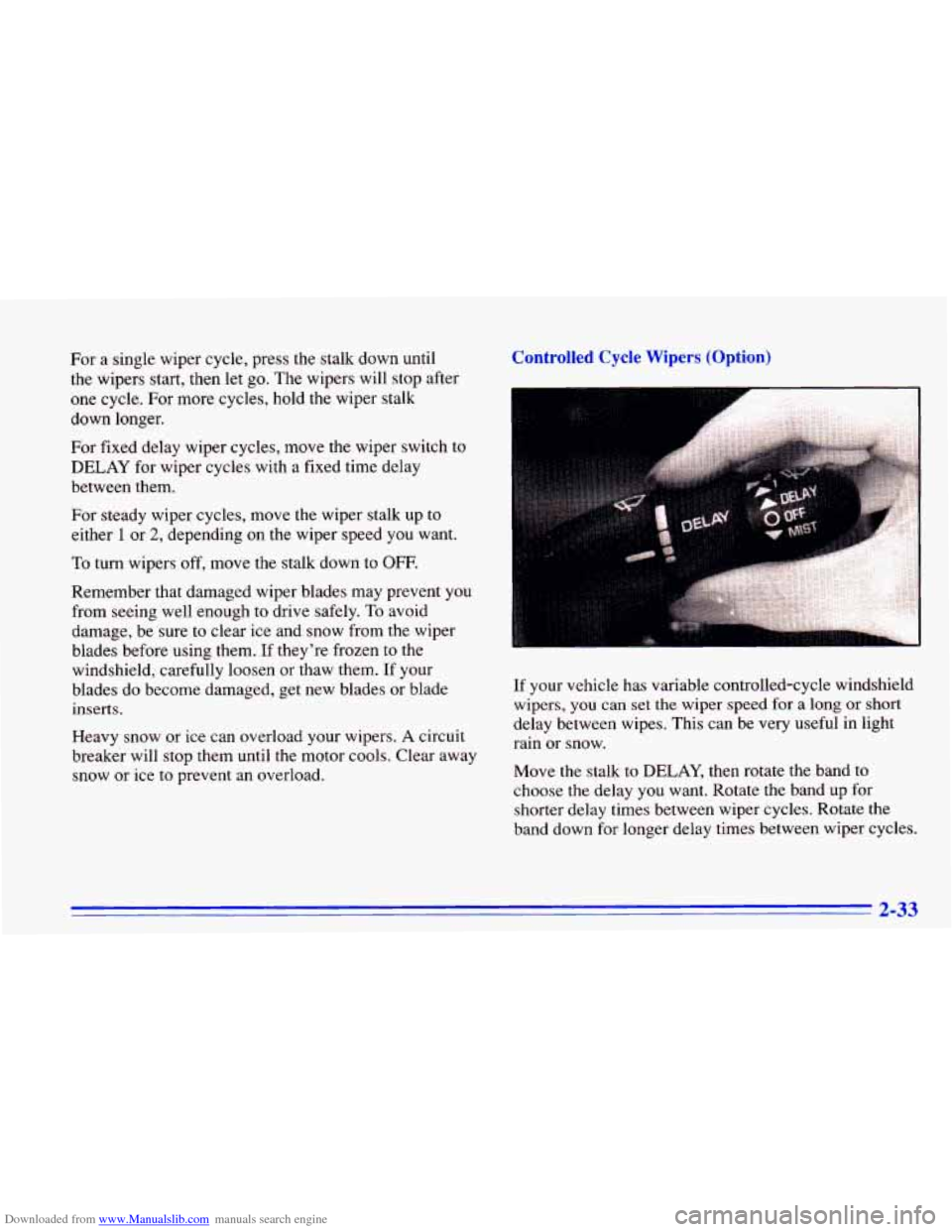
Downloaded from www.Manualslib.com manuals search engine For a single wiper cycle, press the stalk down until
the wipers start, then let go. The wipers will stop after
one cycle. For more cycles, hold the wiper stalk
down longer.
For fixed delay wiper cycles, move the wiper switch to
DELAY for wiper cycles with a fixed time delay
between them.
For steady wiper cycles, move the wiper stalk up to
either
1 or 2, depending on the wiper speed you want.
To turn wipers off, move the stalk down to OFF.
Remember that damaged wiper blades may prevent you from seeing well enough to drive safely.
To avoid
damage, be sure to clear ice and snow from the wiper
blades before using them.
If they’re frozen to the
windshield, carefully loosen
or thaw them. If your
blades do become damaged, get new blades or blade
inserts.
Heavy snow or ice can overload your wipers.
A circuit
breaker will stop them
until the motor cools. Clear away
snow or ice to prevent an overload.
Controlled Cycle Wipers (Option)
If your vehicle has variable controlled-cycle windshield
wipers,
you can set the wiper speed for a long or short
delay between wipes. This can be very useful in light
rain or snow.
Move the stalk to
DELAY, then rotate the band to
choose the delay you want. Rotate the band
up for
shorter delay times between wiper cycles. Rotate the
band down for longer delay times between wiper cycles.
2-33
Page 92 of 372
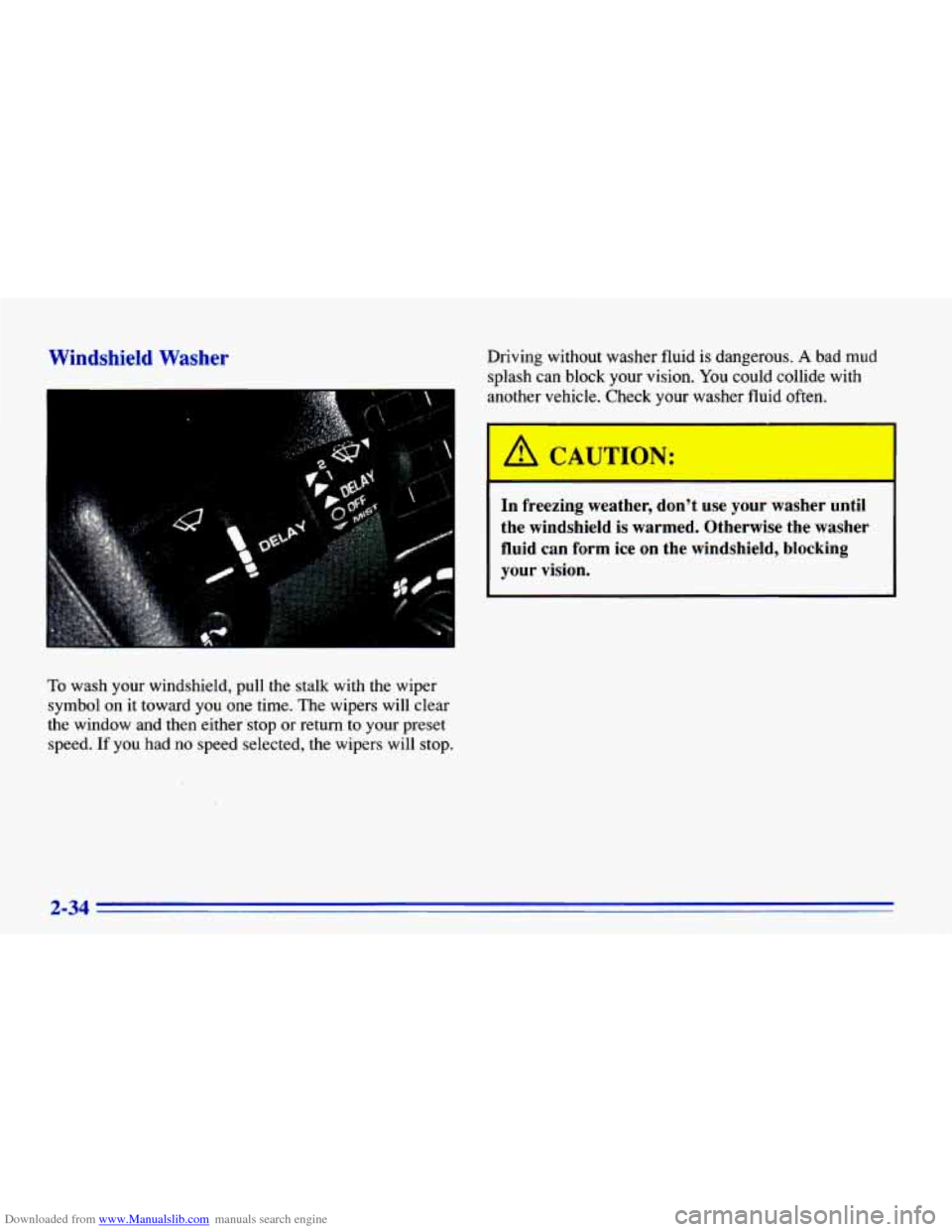
Downloaded from www.Manualslib.com manuals search engine Windshield Washer Driving without washer fluid is dangerous. A bad mud
splash can block your
vision. You could collide with
another vehicle. Check your washer fluid often.
To wash your windshield, pull the stalk with the wiper
symbol on it toward you one time. The wipers will clear
the window and then either
stop or return to your preset
speed.
If you had no speed selected, the wipers will stop.
I
I A CAUTION:
In freezing weather, don’t use your washer until
the windshield is warmed. Otherwise the washer
fluid can form ice on the windshield, blocking
your vision.
2-34
Page 93 of 372
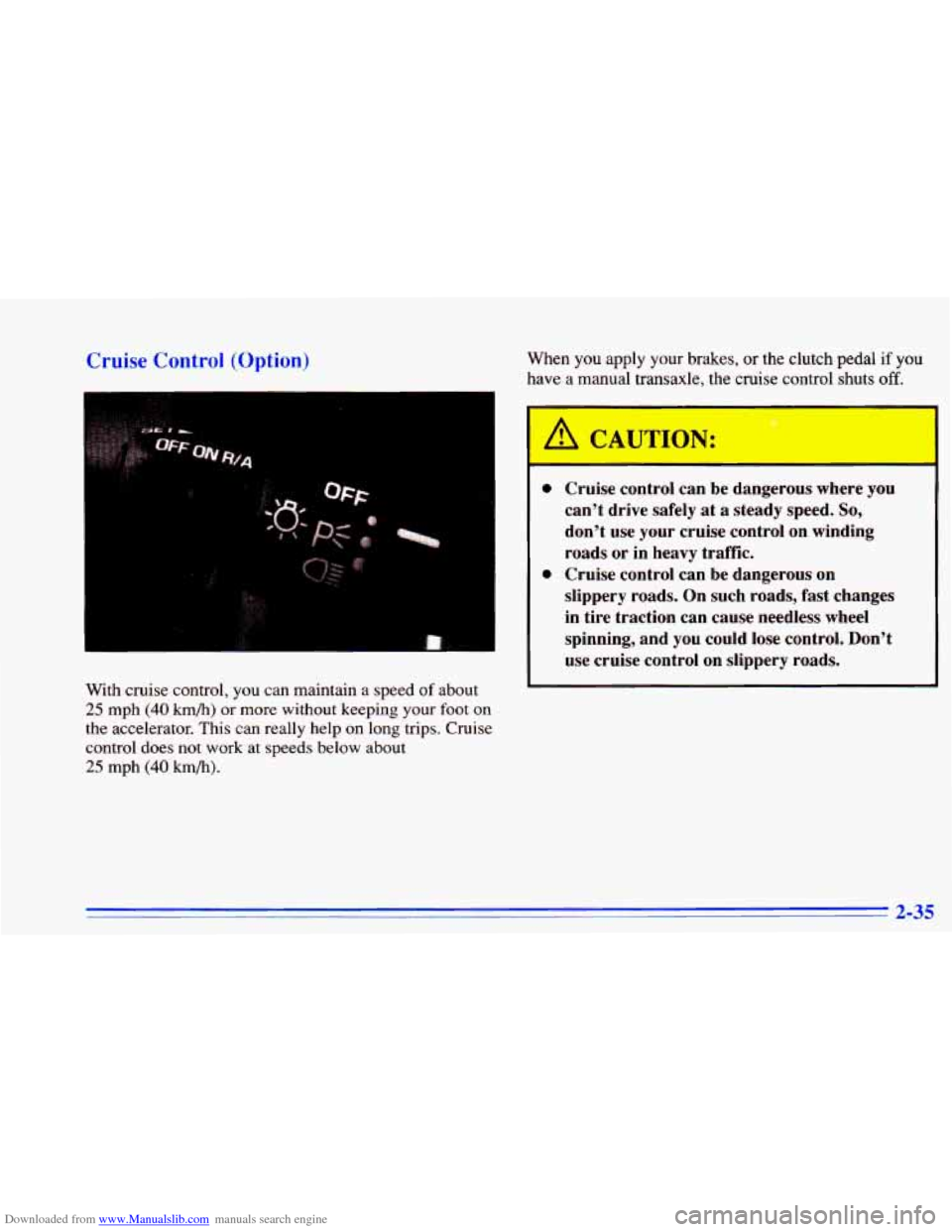
Downloaded from www.Manualslib.com manuals search engine Cruise Control (Option)
With cruise control, you can maintain a speed of about
25 mph (40 km/h) or more without keeping your foot on
the accelerator. This can really help on long trips. Cruise
control does not work at speeds below about
25 mph (40 km/h).
When you apply your brakes, or the clutch pedal if you
have a manual transaxle, the
c ‘se contrc jhu off. *
I
A CAUTION:
0
0
- - -
Cruise control can be dangerous where you
can’t drive safely at a steady speed. So,
don’t use your cruise control on winding
roads or in heavy traffic.
Cruise control can be dangerous on
slippery roads. On such roads, fast changes
in tire traction can cause needless wheel
spinning, and
you could lose control. Don’t
use cruise control on slippery roads.
2-35
Page 94 of 372
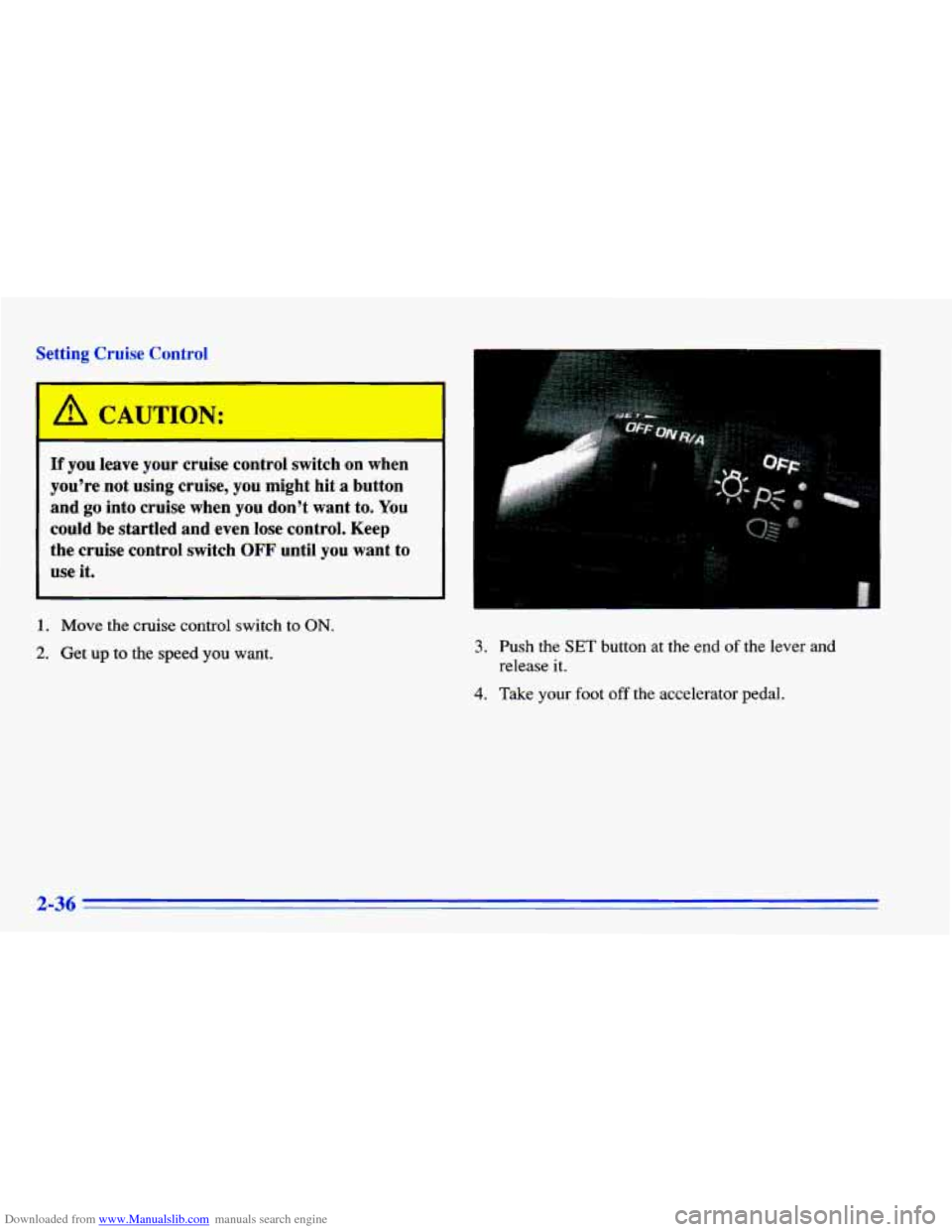
Downloaded from www.Manualslib.com manuals search engine I A CAUTION:
- -
If you leave your cruise control switch on when
you’re not using cruise, you might hit a button
and
go into cruise when you don’t want to. You
could be startled and even lose control. Keep
the cruise control switch
OFF until you want to
use it.
I
1. Move the cruise control switch to ON.
2. Get up to the speed you want. 3. Push the SET button at the end of the lever and
release it.
4. Take your foot off the accelerator pedal.
2-36
Page 95 of 372
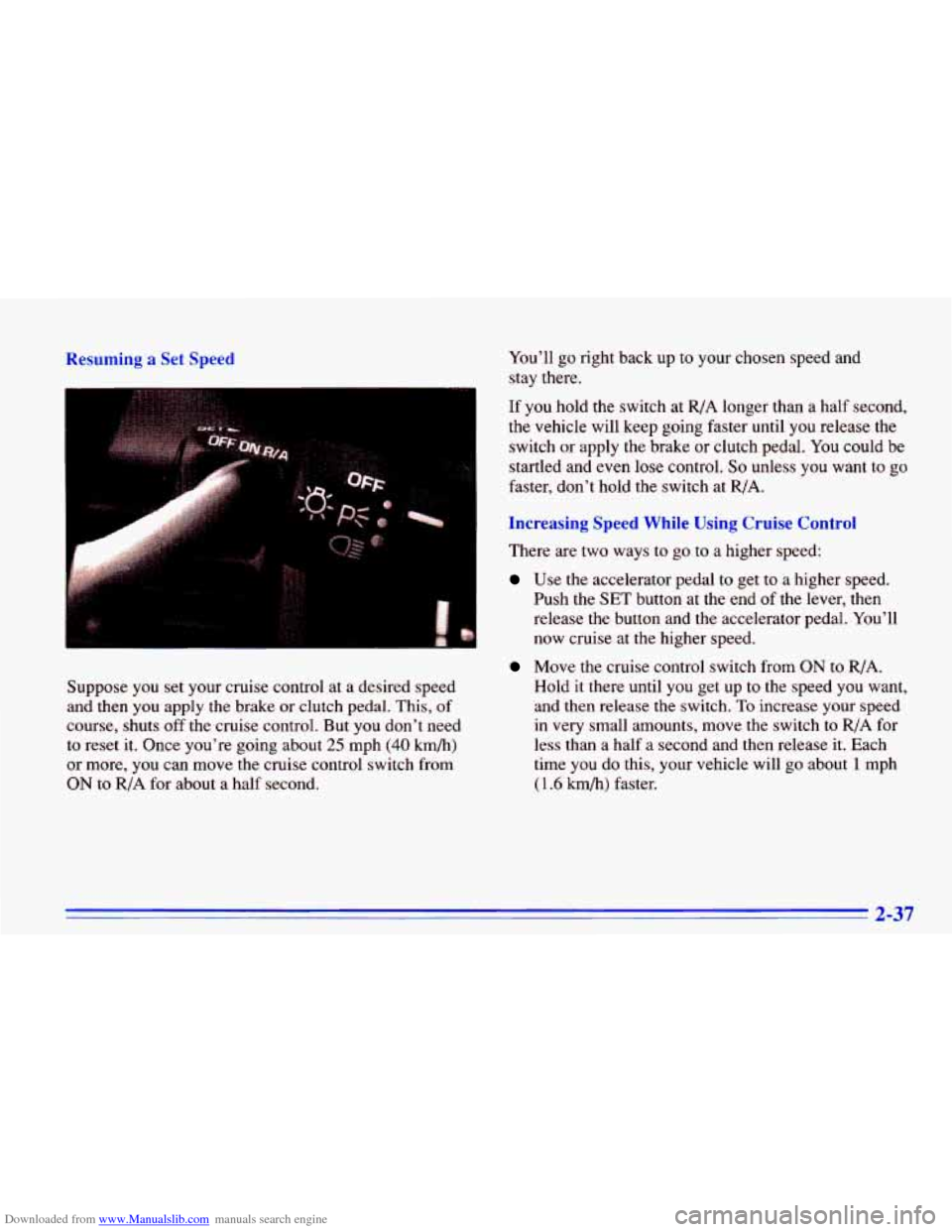
Downloaded from www.Manualslib.com manuals search engine Resuming a Set Speed
Suppose you set your cruise control at a desired speed
and then you apply the brake or clutch pedal. This, of
course, shuts off the cruise control. But you don't need
to reset it. Once you're going about
25 mph (40 km/h)
or more, you can move the cruise control switch from
ON to R/A for about a half second. You'll
go right back up to your
chosen speed and
stay there.
If you hold the switch at
R/A longer than a half second,
the vehicle will keep going faster until you release the
switch
or apply the brake or clutch pedal. You could be
startled and even lose control.
So unless you want to go
faster, don't hold the switch at R/A.
Increasing Speed While Using Cruise Control
There are two ways to go to a higher speed:
Use the accelerator pedal to get to a higher speed.
Push the
SET button at the end of the lever, then
release the button and the accelerator pedal. You'll
now cruise
at the higher speed.
Move the cruise control switch from ON to R/A.
Hold it there until
you get up to the speed you want,
and then release the switch.
To increase your speed
in very small amounts, move the switch to RIA for
less than
a half a second and then release it. Each
time
you do this, your vehicle will go about 1 mph
( 1.6 h/h) faster.
2-37
Page 96 of 372
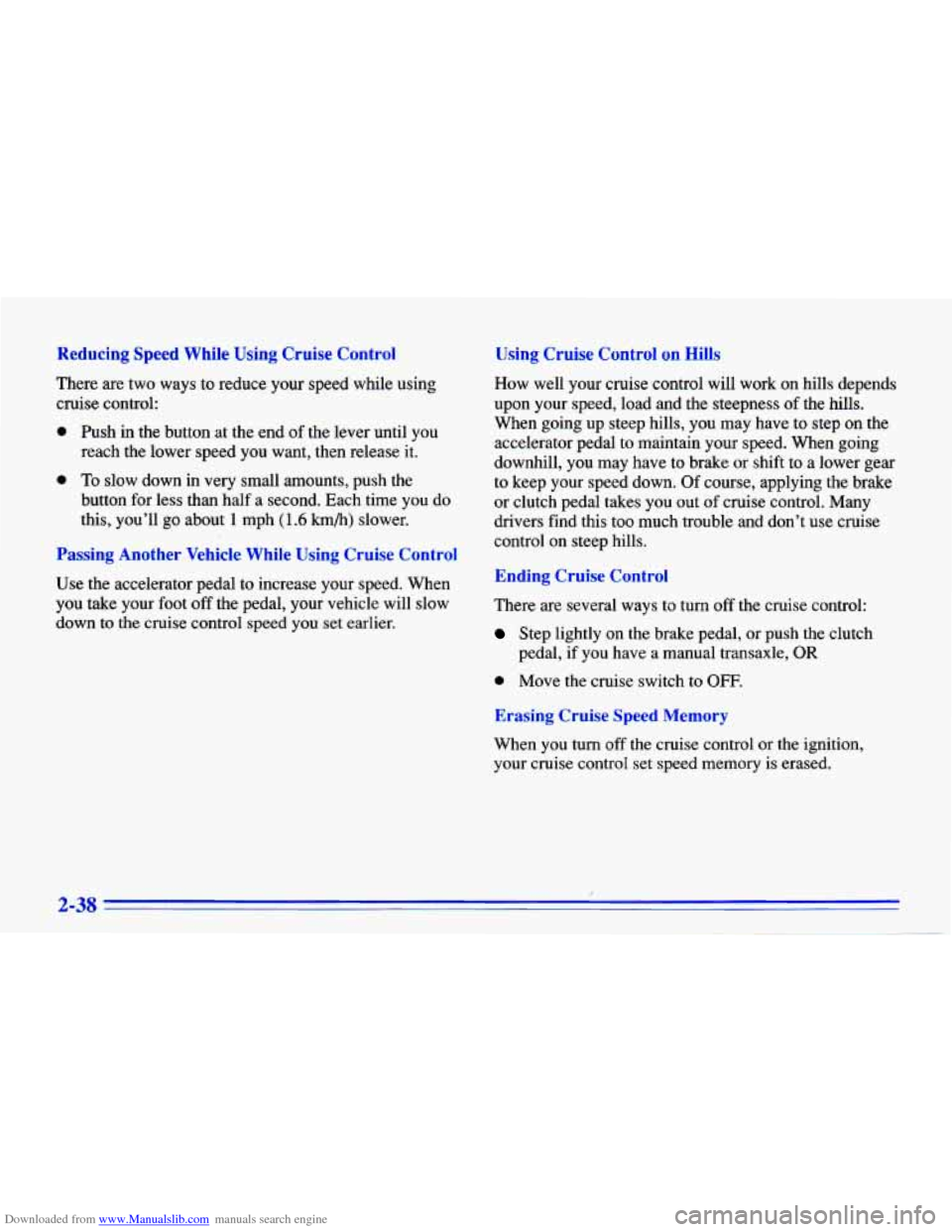
Downloaded from www.Manualslib.com manuals search engine Reducing Speed While Using Cruise Control
There are two ways to reduce your speed while using
cruise control:
0 Push in the button at the end of the lever until you
reach the lower speed you want, then release
it.
0 To slow down in very small amounts, push the
button for less than half a second. Each time you do
this, you’ll
go about 1 mph (1.6 h/h) slower.
Passing Another Vehicle While Using Cruise Control
Use the accelerator pedal to increase your speed. When
you take your foot
off the pedal, your vehicle will slow
down to
the cruise control speed you set earlier.
Using Cruise Control on Hills
How well your cruise control will work on hills depends
upon your speed, load
and the steepness of the hills.
When going up steep hills, you may have to step
on the
accelerator pedal to maintain your speed. When going
downhill, you may have to brake or shift to a lower gear
to keep your speed down. Of course, applying the brake
or clutch pedal takes you out of cruise control. Many
drivers find this too much trouble and don’t
use cruise
control on steep hills.
Ending Cruise Control
There are several ways to turn off the cruise control:
Step lightly on the brake pedal, or push the clutch
0 Move the cruise switch to OFF.
pedal, if you have a manual transaxle, OR
Erasing Cruise Speed Memory
When you turn off the cruise control or the ignition,
your cruise control set speed memory is erased.
2-38
Page 97 of 372
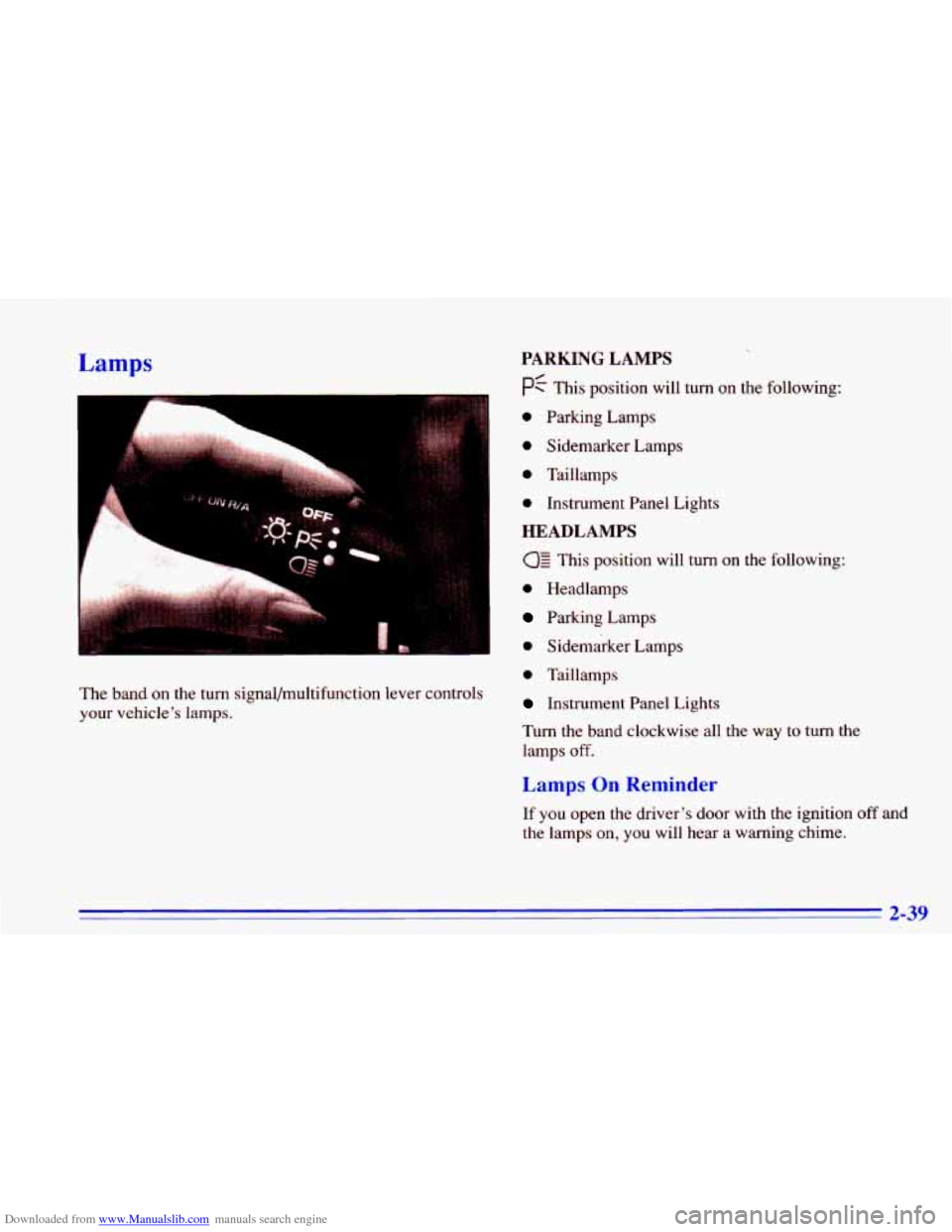
Downloaded from www.Manualslib.com manuals search engine Lamps
The band on the turn signal/multifunction lever controls
your vehicle’s lamps.
PARKING LAMPS
pf This position will turn on the following:
0 Parking Lamps
0 Sidemarker Lamps
0 Taillamps
0 Instrument Panel Lights
HEADLAMPS
This position will turn on the following:
0 Headlamps
Parking Lamps
0 Sidemarker Lamps
0 Taillamps
Instrument Panel Lights
Turn the band clockwise all the way
to turn the
lamps
off.
Lamps On Reminder
If you open the driver’s door with the ignition off and
the lamps on, you will hear a warning chime.
2-39
Page 98 of 372
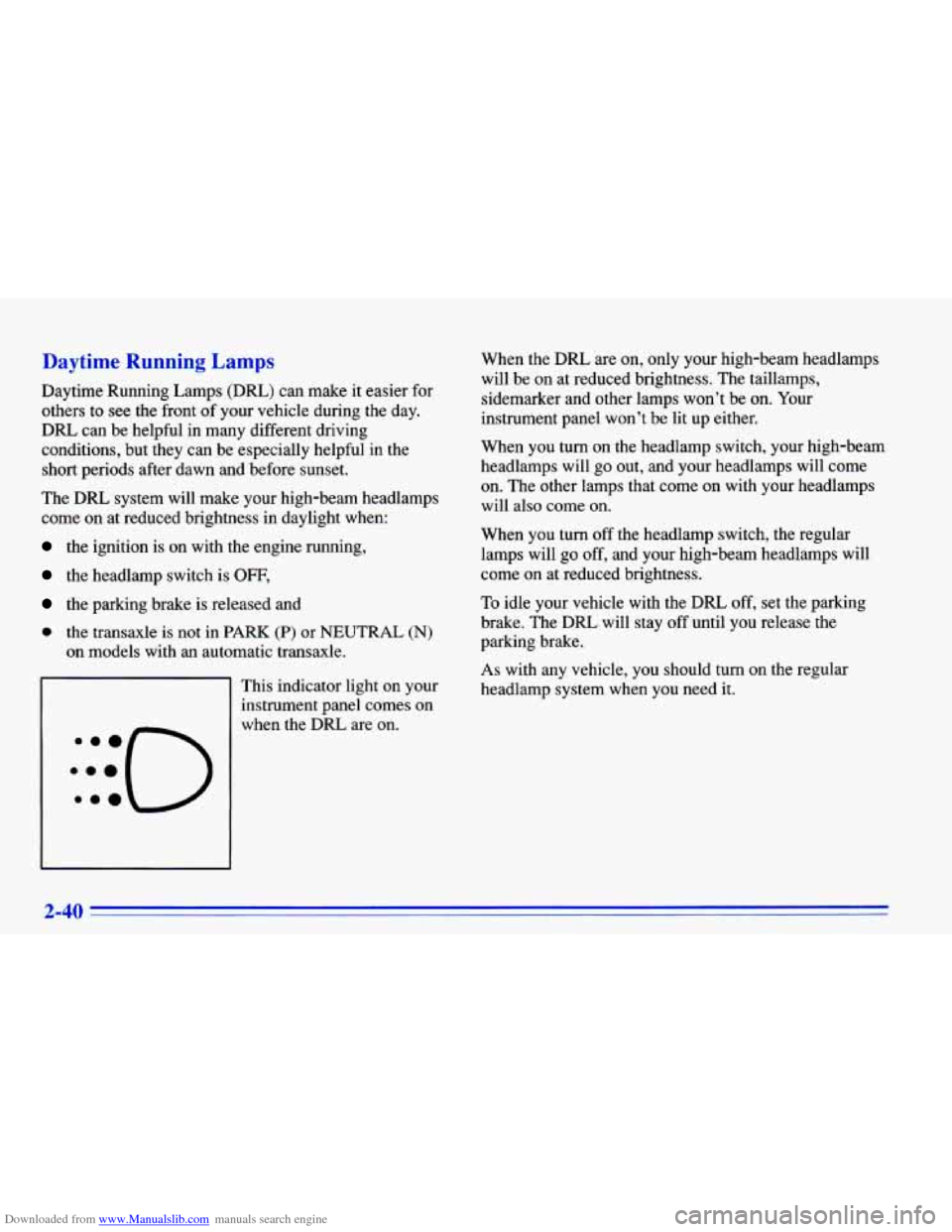
Downloaded from www.Manualslib.com manuals search engine Daytime Running Lamps
Daytime Running Lamps (Dm) can make it easier for
others to see the front of your vehicle during the day.
DRL can be helpful in many different driving
conditions, but they can be especially helpful
in the
short periods after dawn and before sunset.
The
DRL system will make your high-beam headlamps
come on at reduced brightness
in daylight when:
the ignition is on with the engine running,
the headlamp switch is OFF,
the parking brake is released and
0 the transaxle is not in PARK (P) or NEUTRAL (N)
on models with an automatic transaxle.
This indicator light on your
instrument panel comes on When the
DRL are
on, only your high-beam headlamps
will be on at reduced brightness. The taillamps,
sidemarker and other lamps won’t be on. Your
instrument panel won’t be lit up either.
When you turn on the headlamp switch, your high-beam
headlamps will go out, and your headlamps will come
on. The other lamps that come on with your headlamps
will also come on.
When you turn
off the headlamp switch, the regular
lamps will go off, and your high-beam headlamps will
come on at reduced brightness.
To idle your vehicle with the DRL off, set the parking
brake. The
DRL will stay off until you release the
parking brake.
As with any vehicle, you should turn on the regular
headlamp system when
you need it.
2-40
Page 99 of 372
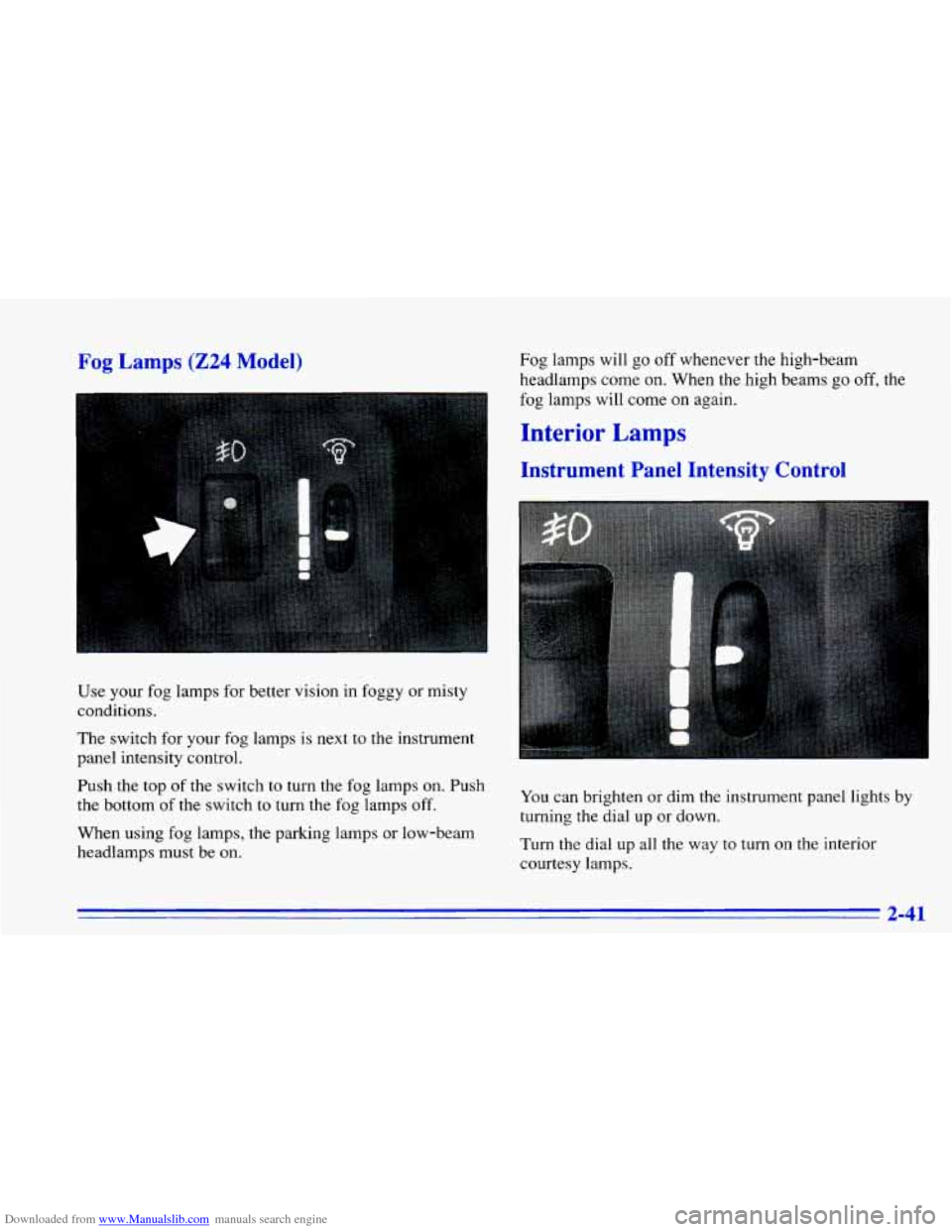
Downloaded from www.Manualslib.com manuals search engine Fog Lamps (224 Model) Fog lamps will go off whenever the high-beam
headlamps come on. When the high beams
go off, the
fog lamps will come
on again.
Interior Lamps
Instrument Panel Intensity Control
Use your fog lamps for better vision in foggy or misty
conditions.
The switch for your fog lamps is next to the instrument
panel intensity control.
Push the top of the switch to turn the fog lamps on. Push
the bottom
of the switch to turn the fog lamps off.
When using fog lamps, the parking lamps or low-beam
headlamps must be on. You
can brighten or dim the instrument panel lights by
turning
the dial up or down.
Turn the dial
up all the way to turn on the interior
courtesy lamps.
2-41
Page 100 of 372
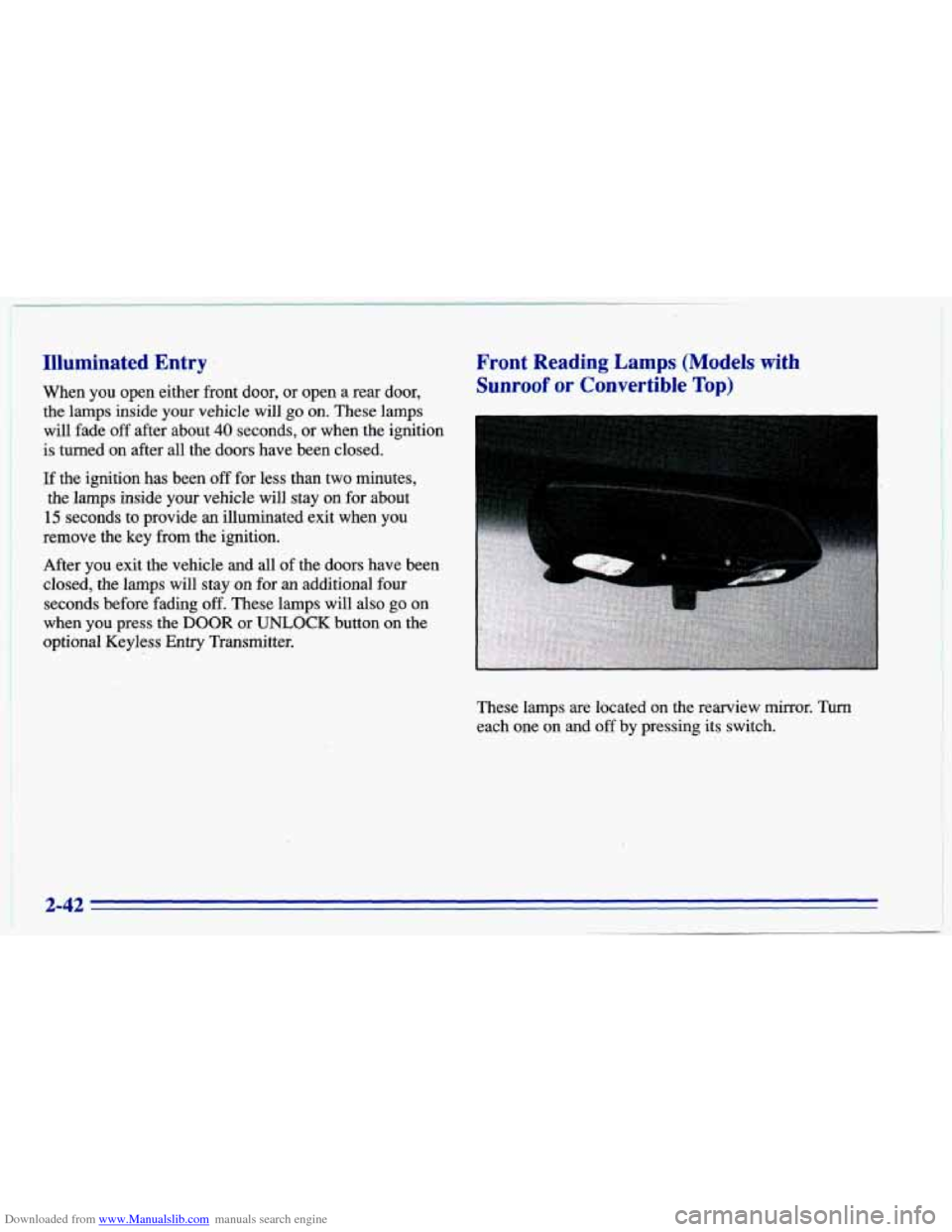
Downloaded from www.Manualslib.com manuals search engine Illuminated Entry
When you open either front door, or open a rear door,
the lamps inside
your vehicle will go on. These lamps
will fade
off after about 40 seconds, or when the ignition
is turned
on after all the doors have been closed.
If the ignition has been off for less than two minutes,
the lamps inside
your vehicle will stay on for about
15 seconds to provide an illuminated exit when you
remove the key from the ignition.
After you exit the vehicle and all of the doors have been
closed, the lamps will stay
on for an additional four
seconds before fading
off. These lamps will also go on
when
you press the DOOR or UNLOCK button on the
optional Keyless Entry Transmitter.
Front Reading Lamps (Models with
Sunroof or Convertible Top)
These lamps are located on the rearview mirror. Turn
each one on and off by pressing its switch.
2-42
1